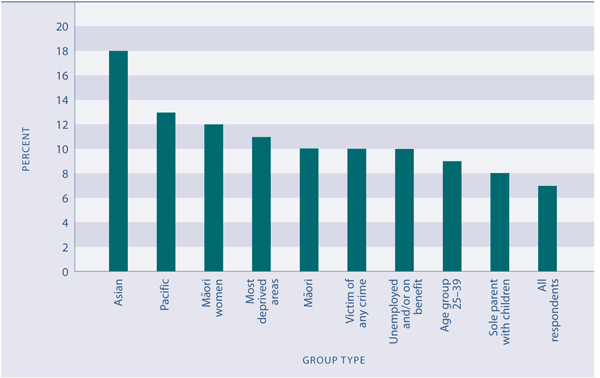Fear of crime
Definition
The proportion of the population aged 15 years and over who said fear
of crime had a moderate or high impact on their quality of life
(scoring its effect at 4 or higher on a scale from 0–10, where 0 is no
effect and 10 is total effect on quality of life), as measured by the
New Zealand Crime and Safety Survey 2006.
Relevance
Anxiety and worries about victimisation detract from
wellbeing, and may cause people to alter their behaviour to avoid being
victimised. This limits people’s options and can reduce their freedom.
Current level
In 2005, 40 percent of New Zealanders said that fear of crime
had a moderate or high impact on their quality of life, scoring its
effect at 4 or higher on a 0–10 scale.
A third (33 percent) scored its effect at 4–7, while 7 percent
scored it at 8–10.
People who had been a victim of any crime were more likely
than average to report that fear of crime affected their quality of
life.
Age and sex differences
Women were more likely than men to report that fear of crime
had a moderate or high impact on their quality of life, with 45 percent
of females and 34 percent of males scoring its effect at 4 or above on
the impact scale. Thirty-seven percent of females and 28 percent of
males reported a moderate impact (scoring it at 4–7), while 8 percent
of females and 6 percent of males reported a high impact on their
quality of life (scoring it at 8–10).
People aged 25–39 years were the most likely to report that
fear of crime affected their quality of life, while people aged 60
years and over were the least likely to do so. In all age groups, women
were more likely than men to say fear of crime had an impact on their
quality of life.
Table SS3.1 Proportion (%) of the
population aged 15 years and over who reported that fear of crime had a
moderate or high impact on their quality of life, by age and sex, 2005
| |
Males |
Females |
| Age group |
High impact
(score of 8–10) |
Moderate impact
(score of 4–7) |
Moderate or high impact
(score of 4–10) |
High impact
(score of 8–10) |
Moderate impact
(score of 4–7) |
Moderate or high impact
(score of 4–10) |
| 15–24 |
4 |
32 |
36 |
8 |
39 |
47 |
| 25–39 |
8 |
31 |
39 |
10 |
44 |
54 |
| 40–59 |
7 |
27 |
33 |
9 |
34 |
43 |
| 60+ |
4 |
24 |
29 |
6 |
31 |
37 |
Source: Mayhew and Reilly (2007a) Table B21
Note: Combined scores may not add up because of rounding
Ethnic differences
At 60 percent, Asian people were far more likely than other
ethnic groups to report that fear of crime affected their quality of
life, either moderately or a great deal. Europeans were the least
likely to do so (36 percent), while Māori and Pacific peoples fell in
the middle of the range, at 47 percent. Asians also had the largest
proportion of any group rating the impact of fear of crime on their
quality of life as high (18 percent). In each ethnic group, women were
more likely than men to report that fear of crime affected their
quality of life.
Table SS3.2 Proportion (%) of the
population aged 15 years and over who reported that fear of crime had a
moderate or high impact on their quality of life, by ethnic group, 2005
|
|
High impact
(score of 8–10) |
Moderate impact
(score of 4–7) |
Moderate or high impact
(score of 4–10) |
| European |
5 |
31 |
36 |
| Māori |
10 |
37 |
47 |
Pacific peoples
|
13 |
33 |
47 |
| Asian |
18 |
43 |
60 |
Source: Mayhew and Reilly (2007a) Table B21
Note: Combined scores may not add up because of rounding
Socio-economic differences
People living in the most deprived areas of New Zealand were
much more likely to report that fear of crime affected their quality of
life (49 percent) than those living in the least deprived areas (33
percent). People in deprived areas were more than twice as likely as
those in the least deprived areas to score the effect of fear of crime
on their quality of life at the high end of the scale (11 percent and 5
percent, respectively).
Differences by household composition
Among households, sole parents living with their children had
the highest proportion reporting that fear of crime affected their
quality of life (46 percent), followed by couples with children (44
percent). People living alone (38 percent) and couples without children
(34 percent) were less likely than average to say fear of crime
affected their quality of life.
Figure SS3.1 Groups whose quality of life
is highly affected (score of 8–10) by fear of crime, 2005

Source: Mayhew and Reilly (2007a) Table B21 |

